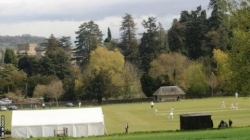'MINOR COUNTIES' TO BECOME “THE NATIONAL COUNTIES CRICKET ASSOCIATION” FROM 2020
Date: 1st March 2019
The Minor Counties are to change their name after 124 years of competitive cricket spanning three centuries.
Herefordshire's Eastnor Castle, home is one of the very many picturesque Minor Counties grounds on the circuit in England and Wales, is shown.
https://www.bbc.co.uk/sport/cricket/46059647
From 2020, the rejigged competition's many changes will include becoming the National Counties Cricket Association.
There will be slightly less three-day cricket, but there will be automatic promotion and relegation within the current Western and Eastern Divisions.
The 10-team divisions will split to two groups of five in a series of changes to the county game at its second tier.
It will also mean a drop in three-day matches from six to four per season, while offering an increase in Twenty20 games.
"It will make it far more competitive," Minor Counties Cricket Association Chair Nick Archer told BBC Sport.
"There'll be no hiding place. We'll have the best sides playing the best sides.
"In the past, there have been occasions when, due to the way the fixtures are set up, with only six games to be played in a 10-team league, you can finish top of the league maybe not having played the three best other sides.
"Now, with more availability of players too, due to there being fewer games, the best team will win it."
There are also plans - still being finalised - to bring back games against first-class sides.
If approved, it would mean a chance for every National Counties side to play against first-class opposition for the first time since Minor Counties sides were excluded from English cricket's premier one-day competition in 2006.
The main changes
-
Automatic promotion and relegation in the Minor Counties Championship.
-
Two five-team groups in both Western and Eastern Divisions.
-
The fifth county in each regional First Division to be relegated and replaced by the respective Division Two winners.
-
A reduction from six three-day games per season to four games.
-
The MCCA final would now be between the Division One East and Division One West winners.
-
An increase in the number of matches in the 50-over Minor Counties Trophy, by reverting from a straight knockout tournament to the old group format with quarter-finals and semi-finals. Counties would be guaranteed at least two home 50-over matches.
-
The Minor Counties T20, which was successfully re-introduced in 2018, would be retained with four groups of five - different ones to the Trophy - with the group winners progressing straight to Finals Day.
-
The three Minor Counties competitions are expected to be played in blocks throughout the season. It has been proposed that the Trophy would be at the start of the season, followed by the T20 in the middle, then the three-day competition at the end.
Eastern Division teams
-
Bedfordshire, Buckinghamshire, Cambridgeshire, Cumberland, Hertfordshire, Lincolnshire, Norfolk, Northumberland, Staffordshire, Suffolk.
Western Division teams
-
Berkshire, Cheshire, Cornwall, Devon, Dorset, Herefordshire, Oxfordshire, Shropshire, Wales, Wiltshire.
'We didn't want to sound 'second rate'
The changes were also officially approved at a meeting in London on Monday with the England and Wales Cricket Board, who have now also agreed to the name change, which still needs to be officially rubber-stamped at the Minor Counties' next meeting.
But discussions between the Minor Counties Cricket Association and the ECB have been taking place for more than a year about the future structure and funding of Minor Counties cricket - and the changes first proposed by a review group led by former Staffordshire opening batsman Archer were initially approved at a meeting at Edgbaston on 31 October.
"We'd had a good steer that this would all be approved," said Archer. "But, until you see it all agreed, it's not certain, so there is a feeling of relief. We knew the game had to change.
"As to the name change, it has long been felt that Minor Counties seemed a pejorative term. And we should now be called from 2020 the National Counties Cricket Association.
"Other names were suggested but made us sound a second-rate organisation and this has now been approved by the ECB."
Minor Counties Championship history
-
The first outright winners of the Minor Counties Championship in 1896 were Worcestershire.
-
Having shared the title with Durham and Norfolk in the inaugural season in 1895, Worcestershire then also won in 1897 and 1898.
-
They then became the first Minor County to be upgraded to first-class status when they were invited to join the County Championship in 1899.
-
After sharing the title in 1899 and 1900, then winning it outright in 1903 and 1904, Northamptonshire were the next to become a first-class county in 1905.
-
Glamorgan played Minor Counties cricket, winning one shared title in 1900, before attaining first-class status in 1921.
-
Durham, who won seven outright and two shared Minor Counties titles, are the most recent side to become a first-class county in 1992, which enabled Herefordshire to take their place in Minor Counties cricket.
-
Staffordshire have won the Minor Counties title the most times - 11, between 1906 and 2014.
-
Until the turn of the 21st century, from Sydney Barnes to Geoffrey Boycott and Ian Botham, many of the game's greats played in Minor Counties cricket, for their counties' Second XIs.
Minor Counties in the cups
Minor Counties sides first played first-class sides in competitive one-day cricket in the 1964 Gillette Cup, when the top five Minor Counties sides in 1963 were placed in the first round draw.
The first upset was in 1973 when Durham, 19 years before they achieved first-class status, became the first Minor Counties side to defeat a first-class county in the competition, beating Yorkshire by six wickets at Harrogate.
When the Natwest Trophy began in 1983, the number of Minor Counties sides involved increased to 13, in an expanded first round that also included Ireland and Scotland.
Perhaps the biggest scalp came a year later when Shropshire defeated Yorkshire by 37 runs, after Shrewsbury Town groundsman Brian Perry claimed the key wicket - a return catch from the great Geoffrey Boycott.
Shropshire's side that beat Geoffrey Boycott and Yorkshire at St George's, Telford included: Coventry City goalkeeper Steve Ogrizovic; Shrewsbury Town groundsman Brian Perry; Malcolm Nash, famously smashed for six sixes in an over by Garry Sobers; Steve Gale, now a first-class umpire; Andy Barnard, father of Worcestershire's England Lions all-rounder Ed; and current county coach Bryan Jones
In 2001, Herefordshire's narrow three-wicket win over Middlesex, led by Angus Fraser and containing future England captain Andrew Strauss, was perhaps the most dramatic of the 15 victories by Minor Counties sides against first-class teams.
Minor Counties involvement in the competition ended after the 2005 season when the cup reverted to a league format for the 18 first-class counties, Ireland and Scotland.
When the Benson & Hedges Cup began in 1972, for the first four years, there were two combined Minor Counties North and Minor Counties South sides.
From 1976 to 1979, these changed to Minor Counties East and Minor Counties West.
From 1980 until 1998, the Minor Counties were then cut to just one combined team - during which time they recorded six wins over first-class sides.
Back to top



